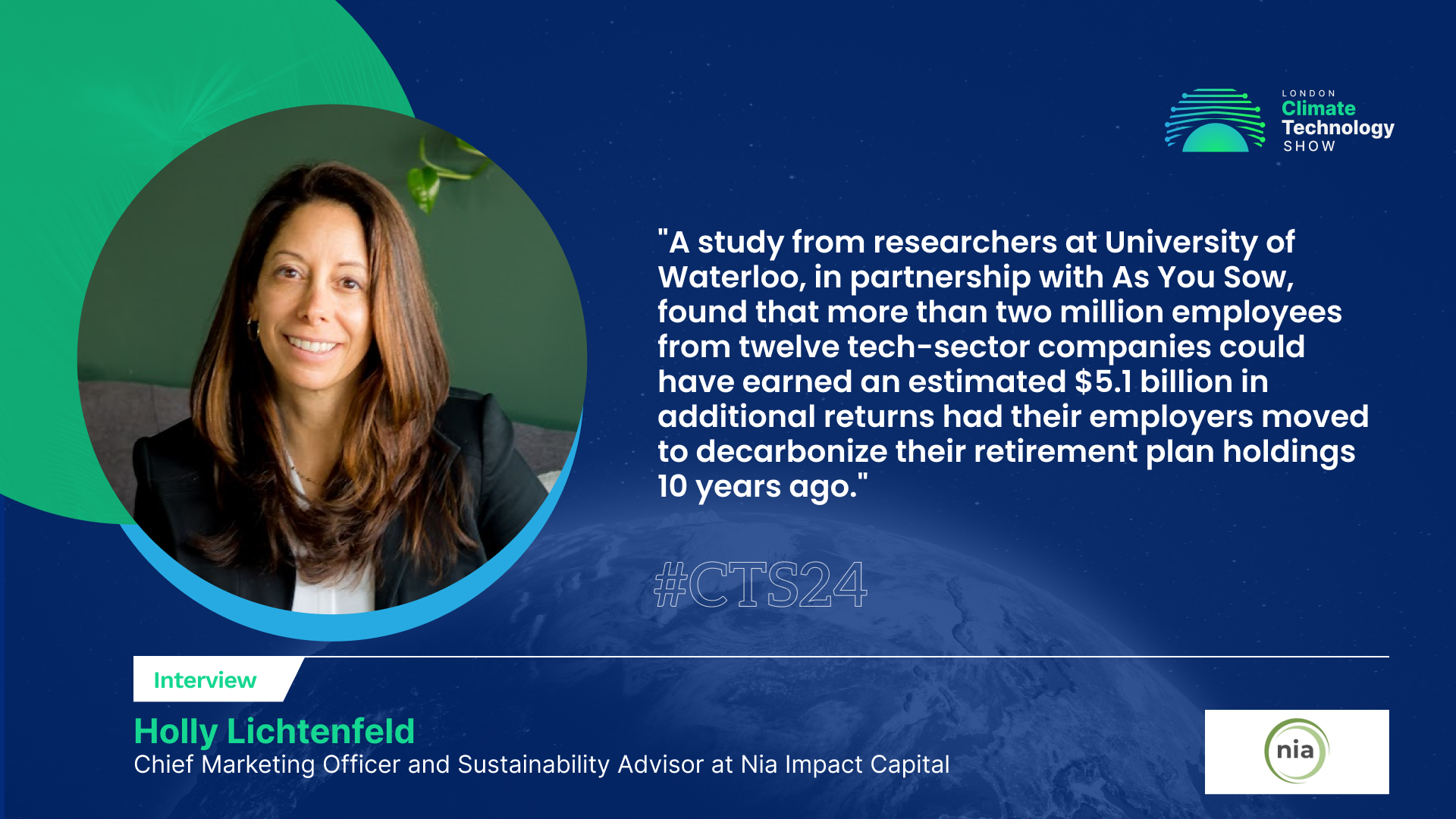Decarbonizing economies isn't just an obligation; it's a gateway to immense investment opportunities. In a recent interview, Holly Lichtenfeld, Chief Marketing Officer and Sustainability Advisor at Nia Impact Capital - an impact investing firm, discussed with Muhammad Younis the abundant prospects in the realm of impact investing. Holly also shared insights on how Nia Impact Capital aids climate solutions’ companies in growing and scaling their operations.
#CTS: In the quest to decarbonize the economy, what are the most overlooked opportunities for investors to both generate returns and drive sustainability? How can these opportunities be effectively discovered and leveraged in today's market landscape?
Holly Lichtenfeld: An overlooked opportunity that is right there for most investors is that they don’t think about the money they have invested in their retirement plans and what it’s funding. According to Forbes, 99% of retirement accounts are invested in oil, gas, and coal. And a study from researchers at University of Waterloo, in partnership with As You Sow, found that more than two million employees from twelve tech-sector companies could have earned an estimated $5.1 billion in additional returns had their employers moved to decarbonize their retirement plan holdings 10 years ago. So choosing a fund that is fossil fuel free like Nia Impact Capital, that invests instead of fossil fuels in climate solutions is a great opportunity to evaluate.
Another opportunity is to invest in funds that engage with companies via shareholder engagement. The approach Nia Impact Capital takes is to be in relationship with corporations on environmental and social justice issues as well as using this process to get to know the people behind the ticker symbols to build win-win relationships.
Renewable energy has been having a tough year but that’s now looking like an interesting opportunity. Nia Impact Capital’s Chief Investment Officer Kristin Hull, was recently quoted in Reuters sharing that “the renewable energy really is on sale right now” and this sentiment was also expressed by a few other finance experts that were interviewed by Barron’s a few days later.
#CTS: What trends do you foresee in the field of impact investing and sustainability over the next decade? How do you think the role of women-led impact investing firms like yours, the Nia Impact Capital, will evolve in the coming years?
Holly Lichtenfeld: Looking ahead over the next decade, I think some large regulatory moves will create interesting sustainability and investing opportunities. This includes global agreements like the United Nations work on a legally binding plastics treaty and a push for more progress on private public partnerships across the sustainability landscape. I also think the interest, awareness, and need to invest at the intersection of sustainability and social/environmental justice will grow over the coming decade.
In terms of the role of women-led firms, currently these firms manage only 0.7% of the $80 trillion USD under management in the U.S. We are involved in initiatives to grow this to 33% by 2033 because we feel that women-led firms play a very important role. With a significant wealth transfer under way, more and more women are coming into control of assets and also more companies are producing products and services designed for women. So things are primed for a shift here.
There is very interesting data that has been shared in the Bloomberg NEF report on Gender Diversity and Climate Innovation. It brings to light how a critical mass of female corporate leaders and board members are a factor in early adoption of climate initiatives, innovation and reporting. It seems to follow that we’d see the same trends with assets managed by women and I look forward to research that will explore this as the number of women managing money increases.
#CTS: How do you assist climate solutions companies in growing and scaling their operations? What methods do you use to measure the impact of companies and governments on climate solutions?
Holly Lichtenfeld: Climate solutions companies are among the holdings in the Nia Impact Capital portfolios. We also engage with companies across sectors to request that they measure and report on Scope 1, 2 and 3 carbon emissions. Additionally we reach out to companies that have said they will be setting Science Based Target Initiative (SBTi) targets but unfortunately seem to be heading toward missing key deadlines.
We engage with leadership at these corporations to give them investor support on climate reporting, transition plans and action.
#CTS: The London Climate Technology Show creates a unique networking environment where diverse stakeholders, from climate innovators to impact investors, converge to explore market opportunities. How do you perceive the impact and significance of such events in driving sustainable innovation and investment?
Holly Lichtenfeld: I have found that connecting with diverse stakeholders at in-person events can create more urgency, speed and depth to conversations. It also results in unexpected and powerful connections that you don’t make when you aren’t in an in person situation where you get to meet people who you might not have otherwise. I’ve heard the term “collisions” used to define how often you run into different, diverse people that you might have an unexpected conversation with and ultimately end up collaborating with. This type of event creates these very human opportunities.

